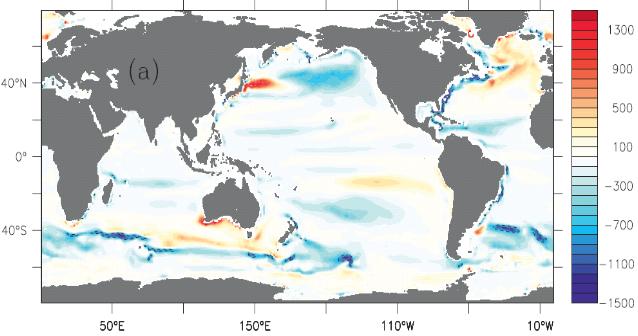Page path:
- Home
- Research
- Ocean and Climate
- Projects & Collaborative Groups
- RACE
- Theme 2
- WP 2.4: Assimilation of optimized mixing parameters and their influence on climate simulations and decadal predictions
WP 2.4: Assimilation of optimized mixing parameters and their influence on climate simulations and decadal predictions
PIs:
Armin Köhl, IfM, CEN, Universität Hamburg, armin.koehl(at)uni-hamburg.de
Detlef Stammer, IfM, CEN, Universität Hamburg, detlef.stammer(at)uni-hamburg.de
Team:
Alberto Elizalde, IfM, CEN, Universität Hamburg
Armin Köhl, IfM, CEN, Universität Hamburg, armin.koehl(at)uni-hamburg.de
Detlef Stammer, IfM, CEN, Universität Hamburg, detlef.stammer(at)uni-hamburg.de
Team:
Alberto Elizalde, IfM, CEN, Universität Hamburg

Corrections of layer thickness diffusion coefficients (in m^27s) at a depth of 310 m determined by fitting an ocean model to the ocean and satellite data, taken from Liu et al (2012).
Diapycnal mixing is of great relevance in the surface boundary layer of the ocean, which largely determines the transfer of the fluxes through the surface into the interior. In addition, mixing plays a central role in the ocean interior, where the horizontal heat fluxes and thus also the surface properties can be modulated by mixing processes. Because these processes can not be resolved in circulation models in the foreseeable future, there is a need to develop parameterizations and to determine appropriate parameters. This provision of mixing processes can help to reduce systematic deviations of coupled climate models with respect to observations.
The last phase of the project has been devoted to the identification and analysis of the optimized mixing coefficients and as a product spatial distributions of diapycnic mixing but also other components of the mixing tensor that can be used in future simulations have been determined.
The present phase will apply the results to coupled climate model simmulations. For this purpose, the fields of optimized mixing coefficients should be incorporated in the MPI-ESM and first the effects on the model climatology are examined. Apart from the goal to reduce systematic model errors, a further focus of the study is to investigate the influence of different components of mixing parameters on the simulated climate, since it is not clear to what extent results obtained in for ocean model can be transferred to the climate model. Depending on the success in the reduction of the error of the coupled model, the influence on the predictive quality of decadal climate predictions are to be investigated.
The last phase of the project has been devoted to the identification and analysis of the optimized mixing coefficients and as a product spatial distributions of diapycnic mixing but also other components of the mixing tensor that can be used in future simulations have been determined.
The present phase will apply the results to coupled climate model simmulations. For this purpose, the fields of optimized mixing coefficients should be incorporated in the MPI-ESM and first the effects on the model climatology are examined. Apart from the goal to reduce systematic model errors, a further focus of the study is to investigate the influence of different components of mixing parameters on the simulated climate, since it is not clear to what extent results obtained in for ocean model can be transferred to the climate model. Depending on the success in the reduction of the error of the coupled model, the influence on the predictive quality of decadal climate predictions are to be investigated.


